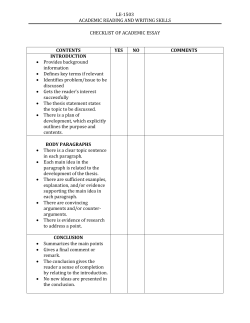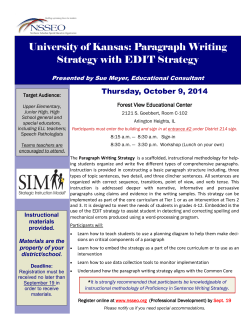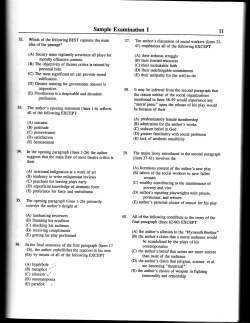
EFFECTIVE READING
EFFECTIVE READING SQ3R Survey Question Survey Read The abstract and/or introduction; The conclusion or summary; Subheadings (usually in bold or italic) If there are no subheadings, look for topic sentences in paragraphs (often the first sentence.) Signposts in a book might include: The preface and/or introduction; The table of contents; The index (look for key words from lectures or essay topics); Charts, tables, figures and photographs and their captions. Question Samples of general questions: Why am I reading this text? Where do I expect to find the information I need? Which parts interest me? Which parts do I expect will be different? Ways to generate specific questions include: Using essay or assignment questions; Paying attention to questions the author generates (you may have come across these in your survey of the text); Looking for definitions, Related resources: Effective Listening Note Taking Tips Review Rephrasing titles, chapter headings and subheadings as questions by adding question words – who, what, where, when, why and how – or even “so what?” Write all your questions down before you move on Skim read and look for signposts. Signposts in a book chapter or journal article might include: Recall to the next stage. Read Read the text at your own speed, pausing to think when a concept is difficult or when you recognise the answers to one of your questions. It’s best not to take notes at this stage – concentrate on reading and thinking. If you must take notes, use key words – don’t copy out screeds of text. Recall This is where the note taking begins. Close the book and, using your own words, try to answer the questions you posed earlier, or, if none of your questions were answered, try to recall the MAIN POINTS of what you have just read. You can do this in writing, of course, but recitation – saying it out loud or talking it over with a fellow student – is also effective. When to pause from reading and start recalling depends on the difficulty of the text. Very difficult reading or material that is entirely new to you may require a recall session after every paragraph. Review Go back to the text to check whether your recall was accurate and complete: Add to or correct your notes as necessary; Student Learning | Te Taiako victoria.ac.nz/student-learning student-learning@vuw.ac.nz +64 4 463 5999 Do this as many times as you need to, to recall and understand the relevant information. Related resources: Effective Listening Note Taking Tips Student Learning | Te Taiako victoria.ac.nz/student-learning student-learning@vuw.ac.nz +64 4 463 5999 Previewing Text This is another activity you can do before you start reading: Read the title and rephrase it as a question to be answered by the text Think about what you know already about the topic Examine the subheadings, create a ‘map’ of the text sub-topics Look briefly at the illustrations, graphs, tables etc. Skim read the introductory paragraph and the concluding paragraph Quickly read the first sentence of every paragraph
© Copyright 2025
















